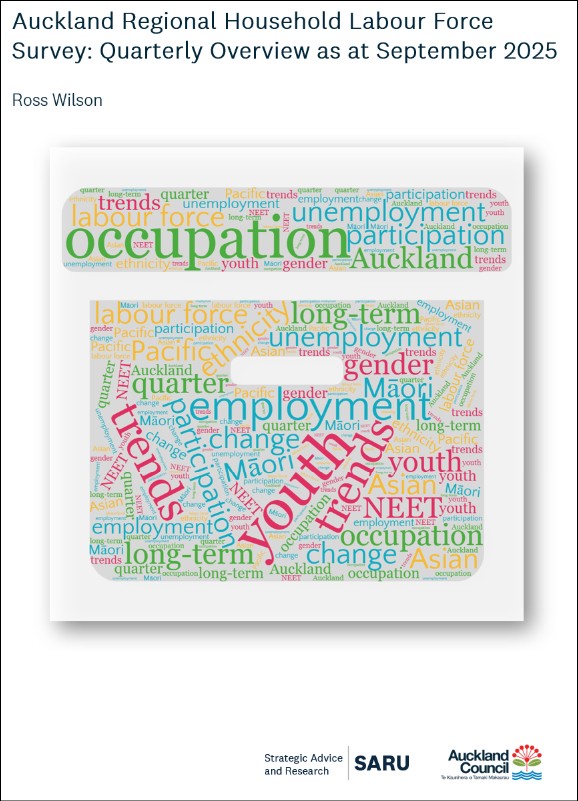Auckland regional household labour force survey: quarterly overview as at September2025
Author:
Ross WilsonSource:
Auckland Council Strategic Advice and Research Unit | Statistics New ZealandPublication date:
2025Topics:
EconomyAn overview of labour force participation in Auckland, as indicated by results of Stats NZ's quarterly Household Labour Force Survey. HLFS
Overview and highlights
For the September 2025 quarter, compared to the preceding quarter (June 2025):
- Auckland’s unemployment rate was 6.1%, same as in June 2025, and the second-highest rate since 2015.
- The number of people who were unemployed was almost unchanged at 63,800.
- The number of people employed fell slightly to 980,100 (-2,100, a 0.2% fall).
- The number of people not in the labour force (NILF) rose 2% to 427,700 (+7,300).
- The labour force participation rate (LFPR) fell 0.4% to 70.9%: the lowest in four years, similar to 2016-2019, but note that LFPR 2021-2025 had been at record highs.
In addition, for the September 2025 quarter:
- The rate of people aged 15 to 24 not in employment, education or training (NEET) was 13.9%, slightly above the rest of New Zealand (12.1%) and slightly above September 2024 (12.1%).
Over the year ended September 2025, compared to the year ended September 2024:
- The unemployment rate averaged 6.0%, higher than a year earlier (4.7%) by a third.
- The largest proportionate increase in unemployment rate was for those aged 40 to 54, rising from 2.8% to 4.3%; younger people had higher rates: 15 to 19 (28.0%, up from 23.0%), 20 to 24 (11.7%, was 9.1%) 25 to 39 (5.0%, was 3.8%), 55 and over 3.0%.
- The unemployment rate for females averaged 6.4% (1.2% above a year prior (5.2%)). The rate for males averaged 5.7% (1.4% above 4.3% a year prior), so the gap between males and females (0.7%) stayed below the 20-year average (0.8%) and peak (2.5%).
- Unemployment rates rose for all main ethnic groups. Māori and Pacific rates remain higher than the others: Māori at 13.3% (up from 9.7%), Pacific peoples at 11.7% (was 8.6%); Asian rose to 5.5% (from 4.2%), European rose by the least to 4.1% (was 3.7%).
- The labour force participation rate (LFPR) fell to 71.8%, down from a year earlier (73.5%) but remaining higher than any time before 2023.
- The LFPR for females decreased (66.8%, down from 68.7%), remaining significantly lower than for males (77.0%, was 78.3%) and slightly widening the gap to 10.2%.
- LFPRs fell substantially for those aged 15 to 19 (down 4.6% to 38.7%), but much less so for all other ages: 20 to 24 (down 0.5% to 78.5%), 25-39 (87.3%, down 0.8%), 40-54 (87.0%, down 1.1%), and 55 and over (51.1%, down 0.7%).
- LFPRs fell most for Māori (64.3%, down 3.8%) and European (71.9%, down 2.7%), less for Asian (75.9%, down 0.9%); the LFPR for Pacific peoples rose (66.2%, up 0.8%).
In addition, over the year ended September 2025:
- The annual average NEET rate for Auckland was 14.6%, above the rest of New Zealand (12.5%), and a little above the year ended September 2024 (13.1%).
- Auckland NEET rates were highest for Māori (24.3%) and Pacific (21.0%) ethnicities, and for the Southern Initiative area (23.4%); one third (12,400) identified as European.
- Auckland’s NEET rate was higher for those aged 20-24 (17.9%) than 15-19 (11.5%).
Overview published November 2025.
